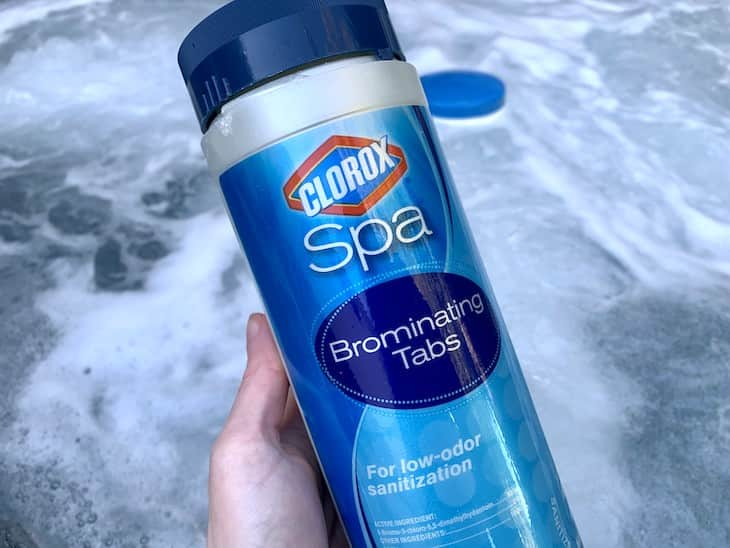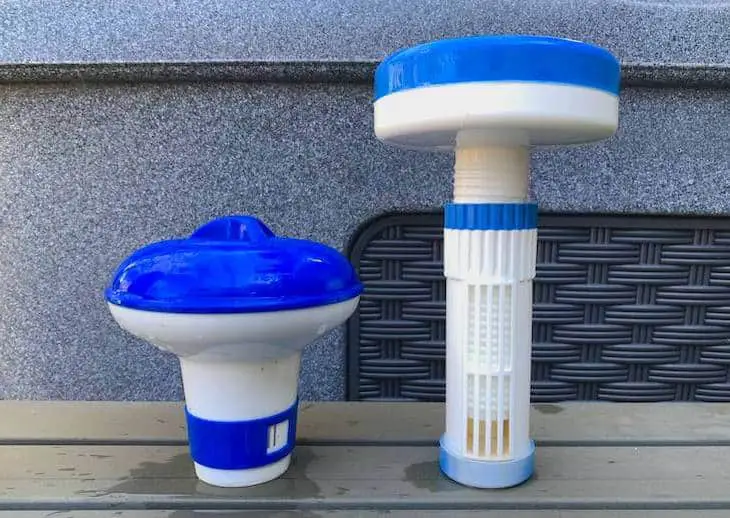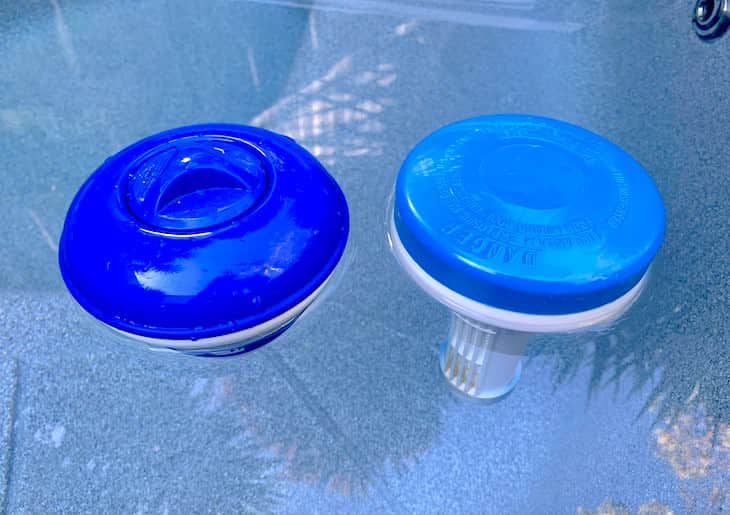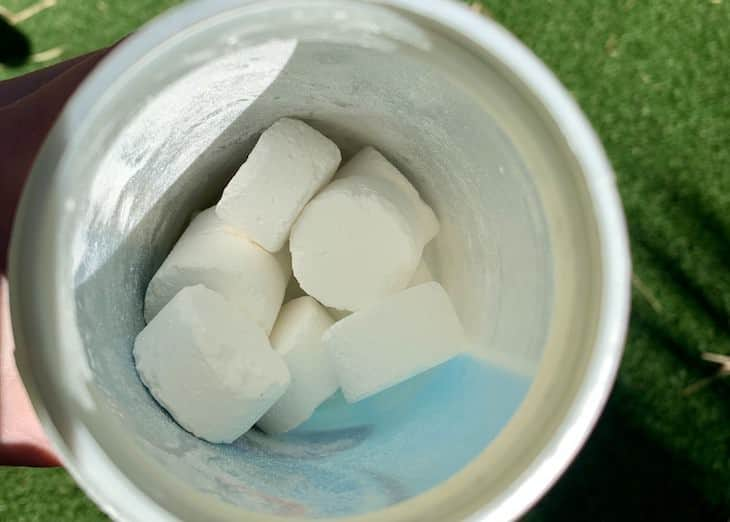How To Use Bromine in a Spa: The Ultimate Guide

By Jennifer Rhodes · Updated
As an Amazon Associate I earn from qualifying purchases.
Ready to get your hot tub sparkling clean? Meet bromine—my favorite hot tub sanitizer. This trusty chemical is the perfect solution for keeping your hot tub water crystal clear, and free of any unwanted guests (we're talking about bacteria, folks).
I've been using bromine in my own hot tub for years and have picked up some tips, tricks, and expert knowledge along the way.
In this article, I'll be sharing my bromine wisdom so you can confidently make it your go-to hot tub sanitizer too. From the dos and don'ts to my personal favorite bromine hacks, you'll have all the knowledge you need to start using bromine effectively and safely in your spa.
And the best part? I'm a hot tub owner just like you and I've been using bromine for years. I'm here to share my tips, tricks, and expert knowledge so you too can make bromine your go-to hot tub ally too.
- Why bromine?
- How do you put bromine in a hot tub?
- What does bromine smell like?
- What is the best type of brominator?
- Should you use a floating bromine dispenser in a hot tub?
- How many bromine tablets should you put in your spa?
- How long should bromine tablets take to dissolve?
- Can you use crushed bromine tablets in a hot tub?
- How long after adding bromine can you use a hot tub?
- What can you do if bromine levels are too high in your hot tub?
- Why might there be no bromine reading at all in your hot tub?
- Can you switch from chlorine to bromine?
- Can you use chlorine test strips for a bromine hot tub?
- How to get started with bromine
Why bromine?
The better known sanitizer you've probably heard of from swimming pools is chlorine, but bromine is a popular alternative—particularly for hot tubs.
Bromine avoids some of the common issues found with chlorine:
- Bromine is gentler on the skin, whereas chlorine is more drying and can be irritating to some people, causing redness, itchiness or rashes
- Bromine has a lower pH, which can make your water balance easier to maintain
- Bromine is more stable, which means the levels stay more consistent, so it lasts longer and doesn't need topping up as often as chlorine
However, there are also a few downsides to be aware of:
- Bromine is more expensive on average
- Bromine is also slightly slower to kill contaminants than chlorine
If you're interested in chlorine instead, I have a similar guide on how to use chlorine in a spa.
How do you put bromine in a hot tub?

Sanitizing a spa with bromine is a usually 3-part process:
- Establish a bromide bank. You need to do this by adding a 'bromide booster' like Spa Choice Bromide Booster Spa Sanitizer each time you initially fill your spa with fresh water. This is to get the water up to an adequate starting bromide level.
- Use shock to activate the bromine. Spa shock works with the bromide to convert it to bromine, which can then kill any contaminants in your water. You should add a shock such as Non-Chlorine Spa Shock for Hot Tub by AquaDoc weekly, as well as after every time you use the spa.
- Add brominating tablets in a floating dispenser or 'brominator'. These tablets dissolve gradually over time. The idea is that they keep your bromide bank topped up just enough, so that there is always enough bromide in the water ready to react when you shock your spa. I've found Clorox Spa Brominating Tablets to be the best value.
When measuring bromine levels, the ideal range to aim for is 2-6 ppm (1-3 ppm is fine if your spa has an ozonator).
And that's really all that's involved. With a little practice, bromine can be a very low-maintenance and convenient way to sanitize a spa.
What does bromine smell like?
Bromine has a mild, clean, slightly bleach-like chemical smell. If the levels are properly maintained, it should be barely detectable, and certainly not overpowering.
It's much milder than the strong 'swimming pool' smell you might associate with chlorinated pools.
Did you know? Chlorine or bromine should have barely any odor if used correctly. 'Swimming pool smell' is actually the result of chloramines or bromamines—chemical compounds released when the sanitizer mixes with unwanted contaminants.
If you ever experience a chemical odor from your bromine spa that smells overpowering, it's a sign you need to shock your water. This will kill the contaminants your bromine has encountered, and convert it back to 'free bromine' so it can be effective again.
What is the best type of brominator?
Brominators are plastic floating devices that hold bromine tablets. They are designed to let the tablets dissolve gradually over time, which keeps your spa's bromide bank topped up. You can usually control how much water comes into contact with the tablets, and therefore how quickly they dissolve.
There are a few different designs of brominator. These are the most common shapes you'll find:

The type on the left is cheaper and more common, but also less sophisticated. The top has an opening and the bromine tablets are placed inside. You twist the bottom to try to limit how much water can get inside, but it's not the most accurate mechanism in my experience.
The one on the right is my preferred type. The tablets stack up inside the tube, and you partially unscrew the bottom to expose the lowest tablet(s). The water cannot reach the tablets above. This design gives you fine-grained control over exactly how much tablet is exposed to the water at once, so not all the tablets will start to dissolve right away.
Should you use a floating bromine dispenser in a hot tub?

A floating bromine dispenser is the easiest way to keep your spa's bromide levels topped up between water changes.
If you don't use one, you'll need to add bromide booster regularly yourself, or just put brominating tablets directly into your spa's skimmer basket if it has one.
It can be harder to get the dose right this way, so you'll often find your sanitizer levels either much too high, or too low (too high is more common in my experience).
Leisure Time Brominating Granular is a bromide booster and shock in one. You can use it to establish an initial bromide reserve, and then add more weekly as a shock. You may not even need to use tablets or a dispenser.
If you do use a bromine floater, it's fine to take it out while you're using the spa if you find it gets in the way.
How many bromine tablets should you put in your spa?

Some bromine dispensers can hold up to 6 tablets, but in most cases you should start with just 1-2 to avoid your bromine levels climbing too high.
If you have one of the better designed floating dispensers like this one, it's safe to add up to 6 1-inch tablets at a time.
If your dispenser looks like this, or you're just adding the tablets to your water without a floater, I'd recommend starting with just 1-2 tablets. You can always add more later.
If you have a large spa, you will likely need to increase the dose, but start cautiously because you can't easily remove bromide once the tablets have already dissolved in the water.
How long should bromine tablets take to dissolve?
Bromine tablets dissolve according to how large the tablets are, and how much of the tablet is exposed to water.
For example, a whole 1-inch tablet fully exposed to water may dissolve in 1-3 weeks, whereas a partially crushed or broken tablet will likely dissolve in just a few hours.
If you use a dispenser like the Life Deluxe Spa/Hot Tub/Pool Chemical Floating Tablet Dispenser, it can take 2-3 months before all the tablets dissolve, at least on the lower settings. This is the slowest and most controlled way to dissolve bromine tablets that I've found since owning a spa.
Can you use crushed bromine tablets in a hot tub?
You can use crushed bromine tablets, either to establish an initial bromide bank or reserve in your hot tub, or (in small amounts) to top up your spa's bromide reserve in place of tablets.
Whenever I've bought a bottle of bromine tablets, there's always been powder in the bottom, where the some of the tablets have been broken or crushed. It seemed a shame to waste, so I experimented with using it in my spa.
What were the results?
I found that it works well in both cases, but a little goes a long way—especially for regular top-ups.
Start by adding a teaspoon of crushed brominating tablet powder to the water. Check the sanitizer levels next time you shock your spa, to make sure it's still within the 2-6 ppm range.
The powder dissolves much more quickly than it would in tablet form, so it's easy to end up with higher levels of sanitizer than you want.
How long after adding bromine can you use a hot tub?
Whenever you shock your spa, you need to wait for the bromine levels to drop before using it. This usually takes around 20-30 minutes, but you should always test before getting in if you are at all unsure.
The reason you must wait after every dose of shock is because it's not bromide booster, but shock, that will alter the bromine levels and determine whether you can safely use your spa.
Never get in a spa if the bromine levels are above 10 ppm, and ideally wait until they are in the 2-6 ppm range.
Remember that if you use bromine tablets, they are actually releasing small amounts of bromide into the water all the time. This in itself is perfectly safe—it's only after adding shock that this will be turned into bromine, killing any harmful bacteria and making your hot tub sparkling clean again.
What can you do if bromine levels are too high in your hot tub?
If you've tested your levels and confirmed the bromine is really too high (above 10 ppm), there are a few things you can try:
- Wait for the levels to decrease naturally. If you don't need to use the spa for a few days, this is often the easiest option. Take your bromine floater out, don't add any more shock, and you'll find the levels will gradually go down on their own.
- Leave the spa open. If you can leave the cover off for a few hours, especially on a sunny day, a combination of evaporation and sunlight will help to break down the bromine faster.
- Replace some of the water. If you can bail out the spa and replace what you took out with fresh water, that will help to dilute the over-sanitized water you have.
- Use a neutralizer. If you're desperate, products like Applied Biochemist Thio-Trine Neutralizer can bring bromine levels down. Be careful though, as instructions on these products are usually for large pools—you'll need a tiny amount for a spa.
- Replace all of the water. This is a last resort, but if you're still struggling to get your levels in an acceptable range, you might be better off with a fresh start and new water.
Why might there be no bromine reading at all in your hot tub?
For hot tub owners new to bromine, it's not always as simple as just adding it to the water and seeing it show up on test strips. In fact, it's a common problem to see no bromine reading at all, especially when you are first setting up the hot tub.
The reason for this is usually that a bromide bank has been built up with sodium bromide, but no shock has been added. Bromine will not be present in the water until it has been shocked, which is what converts the bromide into bromine. So, if you're trying to measure bromine levels and there is no reading, make sure you have added shock to the water.
If the water is not new, another reason for a lack of bromine reading is simply that all the sanitizer has been used up. In this case, shock needs to be added to release the sanitizer again and make it effective in killing bacteria. In other words, if you're having trouble getting a bromine reading, shock is likely the solution you need to get your hot tub back to a clean and healthy state.
Can you switch from chlorine to bromine?
You can switch from chlorine to bromine sanitizer in a hot tub. In fact, it is actually easier to go from chlorine to bromine than the other way around.
Simply stop adding chlorine, and start adding brominating tablets instead. The dissolving tablets will gradually start to build up a bromide bank, and then when you next shock the spa, that residual bromide will be converted to bromine.
It's important that the two chemicals don't mix directly. If you were using a floating dispenser with chlorine, you should get a new one to use with bromine tablets so you can be sure there's no chlorine residue in it.
So why doesn't it work the other way around?
If your spa already has bromine in it, every time you add shock (whether chlorine or non-chlorine), this existing bromine will get reactivated, and you will still have a bromine spa.
There's unfortunately no way to completely remove bromine from the water without doing a full drain, clean and refill—including flushing the plumbing lines with a cleaner like Ahh-Some.
Can you use chlorine test strips for a bromine hot tub?
Most test strips will allow you to test for either chlorine or bromine. If your test strips are 4-way (or higher) this means they can test for both. If you only have 3-way chlorine test strips, then you will need to buy some new bromine-compatible test strips.
These are a good example of 4-way test strips (the '4-way' just means that they read 4 chemical factors: free chlorine, bromine, alkalinity, and pH in this case):

For comparison, these 6-way test strips will also read total chlorine and total hardness:

When you have test strips that can test both bromine and chlorine, simply follow the instructions for bromine readings on the tube. They will use the same set of colored squares; you just need to match against a different number on the scale.
How to get started with bromine
If you're ready to try bromine in your spa for the first time, there are all-in-one starter kits available.
I started with one of these, but to be honest, it wasn't as good value as it seemed. I used up some of the products quickly, and still haven't finished others to this day. Plus, the tablet dispenser it comes with is not the type of design I would recommend.
All you really need to get started with bromine is:
- Bromide booster: Spa Choice Bromide Booster Spa Sanitizer
- Spa shock: Non-Chlorine Spa Shock for Hot Tub by AquaDoc
- Brominating tablets: Clorox Spa Brominating Tablets
- Floating dispenser: Life Deluxe Spa/Hot Tub/Pool Chemical Floating Tablet Dispenser
- Bromine-compatible test strips: JNW Direct Hot Tub Test Strips
